The articles of the current edition are available on the new site.

Predicting the impacts of climate change is no longer only a scientific pursuit, but it has become a societal challenge of great interest to the general public and policy makers, given the large socioeconomic impacts of climate change on everyday life.
A study led by researchers at the National Research Council of Italy – Institute of Atmospheric Sciences and Climate (CNR-ISAC) and the Politecnico di Torino – Department of Environment, Land and Infrastructure Engineering (DIATI) titled “Future climate change shaped by inter-model differences in Atlantic Meridional Overturning Circulation response” compared 30 state-of-the-art climate models, which include in their numerical codes all that we know about the earth system.
Predictions about future climate that are provided by these models are included in the upcoming Intergovernamental Panel on Climate Change (IPCC) report for policy makers. The research team found the uncertainty in the prediction of climate change over Europe strongly depends on the response of the North Atlantic ocean currents to the increase in anthropogenic greenhouse gases.
The researchers found that among the 30 climate models there is a large range in the projected decline rate of the North Atlantic currents, with a spread ranging from a relatively small 18% decrease compared to the pre-industrial climate, to a drastic 74% decrease. The projected climate change over the North Atlantic Ocean and Europe strongly depends on the North Atlantic currents decline rate across the models.
“In the models in which the North Atlantic currents decrease less, there is an enhanced warming in the ocean and over Europe, which is also associated with amplified rainfall. Instead, in the models in which the North Atlantic currents decrease more, the warming and precipitation increases are smaller, but the jet-stream moves poleward changing the influence of the storm tracks over Europe” – explains Katinka Bellomo, lead author of the study, at the Department of Environment, Land and Infrastructure Engineering of the Politecnico di Torino since June, previously at the Institute of Atmospheric Sciences and climate of the National Research council (CNR-ISAC).
 Schematic of the major overturning oceanic currents in the North Atlantic Ocean. Source: http://editors.eol.org/eoearth/wiki/File:OCP07_Fig-6.jpg. Author: R. Curry, Woods Hole Oceanographic Institution/Science/USGCRP.
While previous studies had shown that imposing a reduction in the strength of the North Atlantic ocean currents in a climate model leads to reduced warming in Europe and shifting rainfall patterns, what is novel about these results is that the decrease of the North Atlantic currents can actually explain the differences across the models. Current climate models predict a range in future climate change scenarios depending on the specific parameterizations in each of these models. However, it is not clear which of these parameterizations are responsible for the uncertainties. This team of researchers found that a large part of these uncertainties in predicting future climate change over Europe can be traced back to the response of the North Atlantic ocean.
Schematic of the major overturning oceanic currents in the North Atlantic Ocean. Source: http://editors.eol.org/eoearth/wiki/File:OCP07_Fig-6.jpg. Author: R. Curry, Woods Hole Oceanographic Institution/Science/USGCRP.
While previous studies had shown that imposing a reduction in the strength of the North Atlantic ocean currents in a climate model leads to reduced warming in Europe and shifting rainfall patterns, what is novel about these results is that the decrease of the North Atlantic currents can actually explain the differences across the models. Current climate models predict a range in future climate change scenarios depending on the specific parameterizations in each of these models. However, it is not clear which of these parameterizations are responsible for the uncertainties. This team of researchers found that a large part of these uncertainties in predicting future climate change over Europe can be traced back to the response of the North Atlantic ocean.
“This means that if we are able to predict the response of the North Atlantic currents to greenhouse gases, then we can drastically reduce the uncertainty in the projections of future climate change over Europe. With the continued observational campaigns over the North Atlantic, we are now better able to understand how the ocean works, so an improved representation of the currents in upcoming generations of climate models seems like an achievable and promising task.” – adds Katinka.
“This work highlights the possible climate impacts that could be experienced by people living in European countries, especially if the North Atlantic currents decline so much under the continued influence of human induced climate change that they will nearly shut down, crossing a so-called tipping point.” – says Jost von Hardenberg, co-author of the study and professor at Politecnico of Torino. “In my group we are developing numerical models of varying degrees of complexity to tackle these uncertainties, in collaboration with international research centers.”
The co-authors of this study also include Susanna Corti of CNR-ISAC and Michela Angeloni of Alma Mater Studiorum – University of Bologna, Department of Physics and Astronomy and CNR-ISAC. This investigation was supported by grants from the European Commission in the framework of the collaborative Horizon 2020 projects TiPES and CRESCENDO to CNR-ISAC, and it has just been published in the journal Nature Communications.
The podcast is available online
Image: Free-Photos - Pixabay